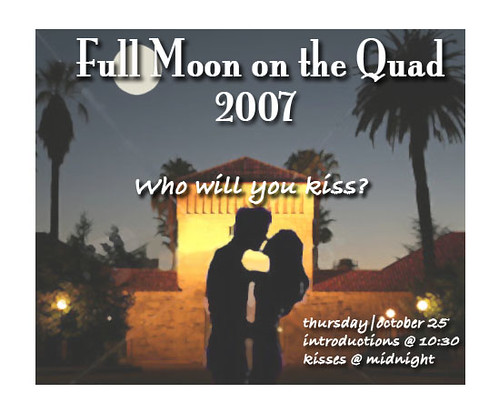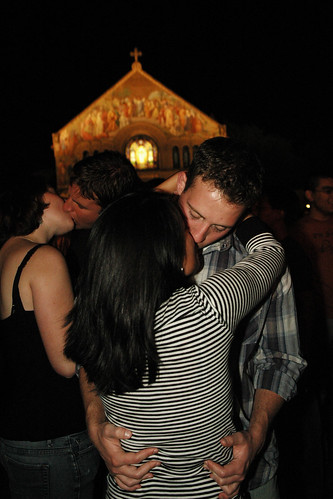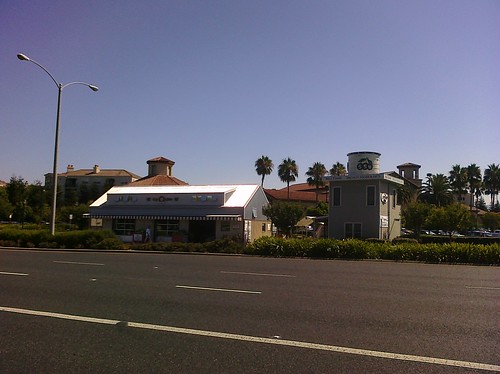Twenty years ago I was an undergrad at Stanford University. I sang baritone in a 16-man a cappella group, the Stanford Fleet Street Singers. We used to have full-group rehearsals twice a week, and an additional weekly rehearsal for each section. The “bari” sectional was Tuesday evenings before dinner. I never liked that abbreviation, “bari.” It always made me think of Barry Gibb and Barry Manilowtwo superstars in their own right, but just not my thing, ya dig? For a while I lobbied to call ourselves the ‘tones but it never caught on. Too bad, it sounds so much cooler.
So we four barisJohn Sullivan, Jason Windawi, Gray Norton, and myselfgathered on Tuesday, October 17, 1989 in the Arroyo dorm lounge in Wilbur Hall to work on our parts for the week. [Thanks, Gray, for filling in the details I forgot!] I don’t remember if we started at 4:30PM or 5:00PM but I do remember that at 5:04PM the whole building shook like it had been hit by a truck. Then it kept on shaking. It was an earthquake. John and Jason were not from California so I think that may have been the first quake they ever felt. They were nervous but excited and enjoying the thrill ride with newbie “so this is an earthquake!” innocence. However Gray’s a native Californian and I’ve been here since I was five so we were old veterans with some perspective and I’ll always remember he and I looking at each other, eyes big as saucers, when we realized after a few seconds that this was very very serious. Scientists may quibble but for us at that moment, in that place, it was The Big One.
We stayed calm and all our elementary school drilling came back to us. We dove under the nearest piece of furniture, a ping-pong table, dragging John and Jason with us. I realized right away that it was a terrible choice. It looked solid enough while we were standing up but from underneath it was pretty much a folding chair with a net. Not sturdy at all. Then I looked around and realized that the table was right next to a lovely floor-to-ceiling picture window. A wall of glassexactly where you don’t want to be in an earthquake. Well, we were the baris and we were tight so I barked a few orders and each of us grabbed a table leg, lifted, and in perfect unison we scooted that table away from the window from underneath, keeping it over our heads the whole time like a Spartan phalanx shielded from Persian arrows. By then the shaking had stopped…I think. I still felt some shaking but I think it was my legs. The window didn’t shatter, the ping-pong table held, the building stood fast (Wilbur Hall is pretty much a concrete bunker), and we were all unharmed.
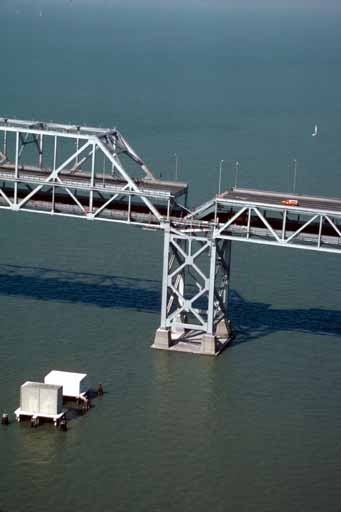 Over the next few hours and days news came in of the magnitude of the quake’s devastation throughout the region. The horror of the Cypress structure collapse in Oakland. The shocking visual of the ruptured Bay Bridge. The tragedies and fires in San Francisco’s Marina District. The destruction of downtown Santa Cruz. We named it for its little-known epicenter, the Loma Prieta Earthquake. We tallied its statistics: 6.9 on the Richter scale, 63 dead, 3,757 injured, 11,000 homes destroyed, 7 billion dollars in damage.
Over the next few hours and days news came in of the magnitude of the quake’s devastation throughout the region. The horror of the Cypress structure collapse in Oakland. The shocking visual of the ruptured Bay Bridge. The tragedies and fires in San Francisco’s Marina District. The destruction of downtown Santa Cruz. We named it for its little-known epicenter, the Loma Prieta Earthquake. We tallied its statistics: 6.9 on the Richter scale, 63 dead, 3,757 injured, 11,000 homes destroyed, 7 billion dollars in damage.
It was a grim day and the losses were staggering, but given the large population and the wide area affected, I’m grateful it wasn’t worse. Emergency responders and hospitals were well-prepared and heroically effective. Not all but most of our critical infrastructurefreeways, bridges, tunnels, utilitieswithstood the quake and continued to serve after brief interruptions. All the A’s and Giants fans at the historic and ironic Bay Bridge World Series got home safely if slowly from Candlestick Park. At Stanford there was significant structure and property damage but no injuries that I’m aware of. With the power out for a while and classes canceled for a few days we huddled and bonded with dorm-mates early in the school year.
In retrospect thankfully the El Camino Real corridor along the Peninsula was relatively unscathed. The Mercury News recently published a chart listing the number of housing units destroyed or significantly damaged in the quake. The most were in San Francisco county: 24,800. The fewest were in Santa Clara county: 1,000. (Ironically Loma Prieta the mountain is actually in Santa Clara county.) San Mateo county isn’t even listed; I take it there were too few to bother counting.
Part of it may be that we had learned our lessons by then, many the hard way. The missionaries who forged El Camino along the mission trail 200 years ago often remarked about the frequent earthquakes but didn’t heed the warnings. Earthquakes damaged or destroyed many early missions. In particular a series of earthquakes around Santa Barbara on December 21, 1812 destroyed or severely damaged seven missions, some of which had to be abandoned and rebuilt elsewhere. There were tragic death tolls. At San Juan Capistrano the two boys ringing the bells for Mass were killed when the tower collapsed.
Still the Spaniards pressed northward, building stronger and stronger structures as they went. I like to think that the pueblos and towns and cities that sprung up along the route inherited the aesthetics of resilience and were built to last. There were mishapsthe Great 1906 San Francisco Earthquake exceeded their ability to preparebut 1989 showed that El Camino has gotten a lot of things right.
It’s interesting to compare El Camino Real with the San Andreas fault, that famous feature responsible for so many historic quakes including 1812, 1906, and 1989. El Camino isn’t literally on top of the fault, though interestingly they do cross near Mission San Juan Bautista. Their similarity is more symbolic. They parallel each other, running south-to-north from roughly the Mexican border to approximately Sonoma county. (The fault at that point slides into the Pacific ocean.) To me they both represent forces of movement and change in the state. The San Andreas fault is the tectonic junction between the Pacific plate and the North American plate. The Pacific plate moves south and the North American plate moves north at a plodding 4-6 centimeters per year. As it rumbles along it shapes the state, pushing up mountains and sealing up valleys and bodies of water. Every so often the plates slip and we feel the temblor. El Camino moves us also, but at a slightly quicker pace. It also moves us forward through time. It’s the juncture of nature and invention. It’s where people plant roots and build things, but never lose the wandering spirit that brought them there. So they constantly rebuild and reinvent, and every now and then deliver a jolt that shakes the world.
It’s perhaps inevitable that El Camino shadows the San Andreas. For the past 25 million years the fault has been defining and reinforcing the orientation of the land. Humans just followed the geological path that was laid before them. Earthquakes will happen and the road will shake but that fateful October evening twenty years ago today, El Camino Real was the natural place to be.


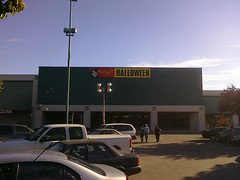 It being the last full weekend before All Hallows’ Eve I expected the store to be crowded but it was not. In years past the checkout lines could reach halfway through the store but this weekend there was no waiting. It could be a sign of the economic times, or simply that the perennial big box stores, party supply stores, and online shopping have pulled customers away. It’s quite ironic to think about a downturn at the Spirit stores since their modus operandi is to exploit real estate doldrums by setting up for a few weeks a year in large vacant buildings. The Santa Clara store is in the old Mervyns building.
It being the last full weekend before All Hallows’ Eve I expected the store to be crowded but it was not. In years past the checkout lines could reach halfway through the store but this weekend there was no waiting. It could be a sign of the economic times, or simply that the perennial big box stores, party supply stores, and online shopping have pulled customers away. It’s quite ironic to think about a downturn at the Spirit stores since their modus operandi is to exploit real estate doldrums by setting up for a few weeks a year in large vacant buildings. The Santa Clara store is in the old Mervyns building. 
 Over the next few hours and days news came in of the magnitude of the quake’s devastation throughout the region. The horror of the
Over the next few hours and days news came in of the magnitude of the quake’s devastation throughout the region. The horror of the 
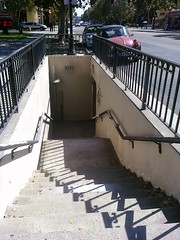 I’m certainly not happy to see the tunnel go. I love the idea of the little critters scampering safely across the busy road through the thoughtfully-provided underpass. El Camino is a great way to go North and South, but it does have this tendency to split land in half, to separate East from West. It’s pretty easy to cross by car; I heard once that the intersection of El Camino Real and San Tomas Expressway in Santa Clara is one of the busiest intersections in the Bay Area. But for everyone else, crossing El Camino can be an ordeal. In 1928 the city of San Jose built a pedestrian subway tunnel under The Alameda for the students of Hester School to use. The subway is dedicated to the memory of Virginia A. Frazer and Charles Loring Sykes, two students who were struck and killed by automobiles while crossing the road. It was commendable of the city to take action to prevent another tragedy. San Diego should take note.
I’m certainly not happy to see the tunnel go. I love the idea of the little critters scampering safely across the busy road through the thoughtfully-provided underpass. El Camino is a great way to go North and South, but it does have this tendency to split land in half, to separate East from West. It’s pretty easy to cross by car; I heard once that the intersection of El Camino Real and San Tomas Expressway in Santa Clara is one of the busiest intersections in the Bay Area. But for everyone else, crossing El Camino can be an ordeal. In 1928 the city of San Jose built a pedestrian subway tunnel under The Alameda for the students of Hester School to use. The subway is dedicated to the memory of Virginia A. Frazer and Charles Loring Sykes, two students who were struck and killed by automobiles while crossing the road. It was commendable of the city to take action to prevent another tragedy. San Diego should take note.


